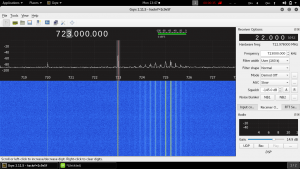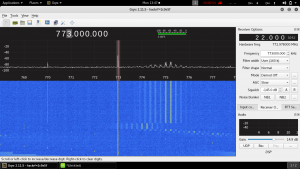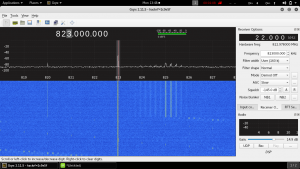Disclaimer: None of the links in this post are affiliate links. I’m just a guy posting a thing. Enjoy.
Preface
For over a year I’ve worked in the cryptocurrency data mining field.
I’m sure by now most people have heard of cryptocurrency, at least Bitcoin. I’ll save the readership my personal feelings on cryptocurrency, the people in it, the politics, and all the rest of those not-so-interesting things. Simply put, it’s complicated. Whatever your opinion is, I probably agree with it in one way or another, because it IS such a complicated issue with multiple angles. But that’s not exactly what this post is about. So, moving on…
When I first started working in “mining” environments I noticed quickly that inside buildings of the first facilities I visited suffered from an almost complete signal degradation from cellular signals. I also had some staff explain to me, “The wifi doesn’t work. It really never has. You just can’t get a signal.”
Being interested in radio and generally curious I immediately had the hypothesis that the mining gear was impacting radio device performance, but I didn’t have the equipment to test it. In February 2018, I came across an article about a man in Brooklyn who was forced to shut down his Bitmain S5 Bitcoin miner because it caused interference on T-Mobile’s LTE network (I found an Ars Technica post about the same here). The article even mention the 700MHz frequency range being used for this.
Shortly after that I bought my HackRF One. The initiated already know this is a radio frequency transceiver for working with software defined radio. Earlier this year I also received the SubGHz Hackerbox that had a SDR usb dongle. I spent some time playing with that, too. I’m not too far into SDR, but it’s really not that hard to fire up some software and look at the noise. So, you guessed it, I set out to check it out.
I have access to several facilities at the time of writing. These facilities have ASIC (Application Specific Integrated Circuit) miner units similar to the S5 and GPU rigs which are basically a computer with six or more GPUs packed into them working in conjunction to process the mathematical calculations for a variety of ASIC resistant algorithms.
The structures are fairly standard wood frame steel siding construction buildings.
The ASICs are primarily either Canaan Avalon 721s or Bitmain S9s with a handful of Bitmain L3s thrown in various places. The GPU rigs are running various cards, mostly AMD R9s. Each of these types of equipment, as one can see, generates a different radio frequency profile.
I focused on observing the 700-900MHz frequency range for the purposes of my testing because this is the range mentioned in the previous article. I verified the use of my local service providers with Wireless Advisor.
Before I continue, I have to stress that I’m fairly novice to SDR and, like any data, this should be examined by others, scrutinized, reproduced if possible, and discussed so that it can be better understood.
Show Me The Data
What my readings in mining environments show are several pronounced radio signals that can be attributed to the mining hardware. This is generally seen in spikes but in testing with Bitmain S9s there were several pronounced radio patterns. Exiting the building we can see these specific frequency spikes drop quickly and, in some cases, the prominence of the nearby radio towers.
I have several screencast videos, each running more than 10 minutes. In these videos I use my HackRF One with an ANT 500 with GQRX running on Kali Linux. I also ran similar tests with a smaller antenna specific to the cellular range. In these videos I move around the facilities, moving in and out of the production area to the outside of the structure.
Below: Video of GPU rig observation with some L3s in the environment.
I find it interesting and noteworthy that a site with nearly 200 Avalon 721s produced a fraction of the radio signal of a site with less than a quarter of that number of S9s. The largest amount of interference at the site with the Avalon 721s was, in fact, a single shelf of S9s for testing. I’ve declined to included the Avalon video in this post simply because it seems so lackluster aside from the moments where I’m standing near S9 units.
It’s also noteworthy that I observed several similar radio patterns around the S9 gear on different frequency ranges, as you can see in the images below.
You can watch a video of the S9 observation below.
Why is this important?
Well, for starters, the article earlier. There is already a proven case of services being impacted by the use or misuse of cryptocurrency mining hardware. It stands to reason that the more gear, the larger the radio footprint will be. This is something significant for miners to consider along with infrastructure planners. The S5 in the article may have been malfunctioning, producing irregular interference, but that is moot since we can see inference as is on functional units and the article proves that the devices are at the very least capable of producing the interference necessary to invoke the attentions of a service provider and federal agencies.
Second, while my tests showed that a simple steel building creates a significant barrier, I imagine someone with sensitive radio equipment could detect signatures of interference caused by cryptocurrency mining hardware. This may be something to consider from the security perspective, and may possibly be a means of “foxhunting” clandestine cryptocurrency mines. This is potentially very important for regions like my own, where there are local government restrictions on cryptocurrency mining.
Third, this could impact the quality of services in the mining environment. I’m not sure if this would have an impact on the ethernet cabling, but it certainly had an impact on Wi Fi historically for me, although, I haven’t done any tests on the WiFi spectrum. While current structures I work in don’t seem to have the same cellular issues as the first mines I worked in, there are some clear indications that there is interference generated on the 700-800MHz frequency range.
Is this “harmful” by the FCC’s definition? Simply put, I can’t answer that. I don’t work in or with such frequencies providing services. I don’t have enough data for a meaningful answer. It’s obvious from the videos that there is interference or other signals that can be attributed to the mining hardware in the 700-900MHz frequency range. It’s also pretty obvious that said signal drops off rapidly once the facility is vacated. The question requires someone far more knowledgeable on radio than myself.
However, one thing that open research and science in general has taught us is that discovery of such conditions is often done by academic inquiry or casual exploration by individuals rather than concentrated investigation by government entities. I encourage anyone who can or would continue this.
Stay Curious.


